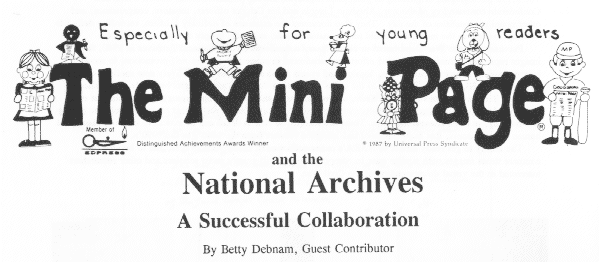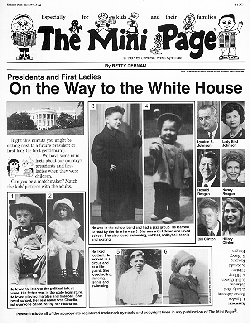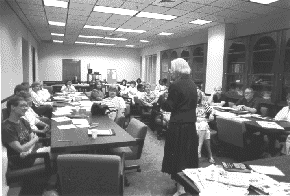
The Record - January 1998
Teaching Approaches
Paula Nassen Poulos, Editor 
The day I walked up the marble steps to the Supreme Court of the United States in 1985 will always be an important one to me. I had been invited there by Chief Justice Warren Burger, newly appointed chair of a commission created to organize the 1987 celebration of the Bicentennial of the U.S. Constitution. Chief Justice Burger proposed that The Mini Page, which I created and edit, publish a series on the Constitution as part of the 200th anniversary commemoration of the Great Charter. The request was a tremendous honor for a children's publication, and I accepted the challenge. What I didn't realize was that this effort would be just the beginning of a rich collaboration between The Mini Page and the National Archives and Records Administration.
About The Mini Page
The Mini Page is a nationally syndicated educational feature for children appearing weekly in 500 newspapers. In most of the papers, it runs as a four-page tabloid. The front and back pages are the educational feature centering on a main theme. The two inside pages contain puzzles based on the theme of the week, as well as recipes, jokes, and a profile of an entertainment or sports personality. Selection of weekly topics is based on current educational trends in the classroom, as well as suggestions from teachers, parents, and kids. A yearly survey of hundreds of schools helps the staff keep up with the interest of its primary audience—elementary school-age children. Holiday themes are depicted in many of the stories. The art on all of the pages is specially designed to be simple in order to attract children to the main feature; it includes cartoon characters, such as Alpha Betty, who teaches reading.
The purpose of The Mini Page is to encourage literacy by introducing young readers to the newspaper-reading habit through an educational feature that is useful to them, their teachers, and their parents. As it was originally conceived and remains today, The Mini Page is a "mini" teaching unit composed of a collection of data about a specific subject. The information is presented in such a way that "children" of all ages and reading levels can learn or relearn from its pages.
For instance, the large type attracts seasoned citizens who might have forgotten some of the information presented. The limited vocabulary and simple presentation makes the information very useful to new arrivals in the United States, who are learning to read English and learning about life in this country. The accuracy of the information is of special value to teachers, who do not have time in their demanding schedules to research all the different topics presented each week in The Mini Page. With delivery of the feature to home doorsteps and school classrooms, The Mini Page has become accessible to a vast audience and is widely regarded as a mass media educational force of national prominence.
The Mini Page office is located in Washington, DC. Its staff of four has access to the rich resources of the federal city, as well as an extensive on-site library of thousands of books, photographs, and reference materials collected during nearly 30 years of operation. Recently the Internet has provided valuable information for the research staff.
The Mini Page uses leading authorities as sources for its articles. After selecting a topic, my staff and I contact one or more of them for background information and suggestions for other resources. Since The Mini Page maintains a very high standing in the educational community, many prestigious institutions and individuals are willing to serve as sources for valuable information and photographs. Included among these are: the National Gallery of Art, for a story about landscape painter Thomas Moran; the State Department, for a story by Secretary of State Madeleine Albright; the Baltimore Orioles, for an interview with the record-setting baseball player Cal Ripken; and Vice President Al Gore, for a story about the Information Super Highway.
Collaboration with the National Archives
Perhaps the most successful collaboration for The Mini Page has been with the National Archives. It had its beginnings in the Bicentennial of the U.S. Constitution project described above. Because the Constitution and millions of other primary documents are housed in the National Archives and because education specialists on the staff could help search for and offer guidance on how to interpret these documents, the National Archives was an ideal partner in this educational effort.
The agency served as the main source for a 21-issue series about the Constitution and later for an 18-issue series about the Bill of Rights. Both series won Educational Press Association Awards.
The National Archives has continued to serve as the main source for other Mini Page issues. Some of the stories have been based on exhibits in the National Archives Building, such as "Soldiers and Animals" (Nov. 27-Dec.3, 1993), "Greek Democracy and Us" (Sept. 17-23, 1993), and "On the Way to the White House" (Jan. 18-24, 1997). Other issues have featured "Women in the Military" (Mar. 18-24, 1995), "African Americans in the Military" (Jan. 28-Feb. 3, 1995), and "Jackie Robinson Breaks Barriers" (Apr. 5-11, 1997).
Use in Classrooms and at Home
The Mini Page is often a part of Newspaper in Education (NIE) projects sponsored by newspapers across the country. A newspaper's NIE staff member is usually a former teacher, whose responsibility it is to promote the use of the newspaper in the classroom. NIE projects often provide sets of daily newspapers for classroom study. Many elementary classroom teachers subscribe to the local newspaper on the day that The Mini Page is published so each child can have a copy of the feature, along with the local paper. The feature and the newspaper then become part of the classroom curriculum, with entire classes often reading and discussing topics from The Mini Page. To assist the teacher in planning learning activities, a teaching guide with suggestions for different grade levels accompanies each issue. This guide is often printed as part of the newspaper but can also be found on The Mini Page Web site at
In the home, The Mini Page often serves as a literacy link between parents and kids, who read it together and discuss its subjects. It is of great use to parents whose job it is to help educate their children and who find it beneficial to have their knowledge refreshed, at the same time, by the information it provides.
Rewards
Although the demands and deadlines of producing a weekly syndicated feature can seem daunting at times, it has been gratifying to hear readers say that it has played a unique role in their lifelong education. For the collaborators—The Mini Page and the National Archives, this cooperative effort to disseminate information about the valuable resources of a public institution through a national newspaper network continues to be most rewarding for both.
Betty Debnam Leads a "Teaching with Documents" Session at NARA
Betty Debnam is the creator and editor of the weekly syndicated newspaper
feature, The Mini Page, located in Washington, DC. She received an undergraduate
degree in political science from the University of North Carolina and a master's
degree in education from Duke University. Publication of The Mini Page began
in 1969 in the News and Observer in Raleigh, NC. Since that time, The Mini Page
and Betty Debnam have received numerous awards from the Educational Press Association
of America for excellence in educational publishing. In 1991 the publication
and its editor received the Department of the Interior's Public Service Award
the American Chemical Society's Grady-Stack award for "interpreting chemistry
to the public." At the request of the White House Historical Association, she
recently authored a book, A Kid's Guide to the White House, published
in 1997 by Andrews and McMeel (4520 Main Street, Kansas City, MO, 64111; 1-800-826-4216).
